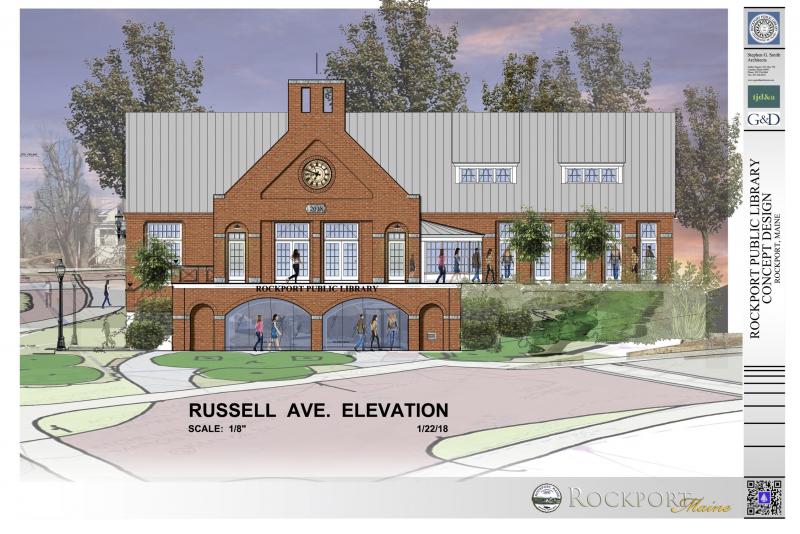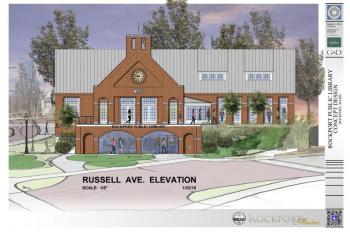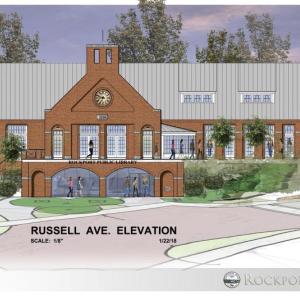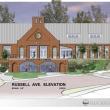Rockport mounts defense of its library construction permit as hearing nears
ROCKPORT — In defense of its own permitting actions, the Town of Rockport, including its planner and code enforcement officer, are maintaining that the town operated in accordance with its ordinances when issuing itself a permit to build a new library in Rockport Village.
In a Sept. 4 letter from Bernstein Schur Attorney Philip Saucier, the town is urging its Zoning Board of Appeals to uphold the permit’s issuance. In the letter, he disputes claims made in an appeal by neighbor Stephen Earle, filed earlier this summer.
The matter will come before citizens Sept. 11, when the town’s quasi-judicial ZBA convenes a hearing on the appeal of the permit.
The ZBA hearing will begin at 5:30 p.m., at the Rockport Opera House at 6 Central Street.
The public is invited to attend the public hearing and may offer testimony. Written testimony may be sent to the Town of Rockport, 101 Main Street. Rockport Maine 04856, attention Code Enforcement Officer.
A ZBA appeal of a Rockport Village project is nothing new to the town: In 2005, the Maine Law Court, Maine’s highest court, heard a case involving the Rockport ZBA and Barbara and Sandy Lewis, ultimately sending that matter back to the Knox County Superior Court to vacate a 2003 Rockport ZBA decision.
That issue occupied the the town for several years and concerned a neighborhood dispute on Sea Street.
Just four years prior to that, in 2001, the Maine Law Court heard an appeal from Maine Coast Artists, which then had its gallery in Rockport Village.
MCA had appealed to Maine’s highest court to overturn a Knox County Superior Court judge’s decision to vacate a Rockport ZBA decision on the contentious neighborhood dispute between MCA and Dorothy Neidig and Patricia Lewis.
The issue concerned the construction of an elevator at MCA, which precipitated an expansion of the building to accommodate the elevator.
The Law Court remanded the issue back to the Rockport ZBA, concluding that MCA had violated part of the town’s ordinance with its expansion project.
The town’s new library project has already been fraught with debate and tension, with half of the town’s citizens who responded to a town-circulated survey last year indicating they wanted the library constructed elsewhere while the other half wanted it built on the library’s existing 1 Limerock Street site.
Debate over parking spaces occupied the Select Board last winter, driving more debate, and now there is opposition to the new library design itself, with a letter submitted by some citizens questioning several aspects of the construction and associated parking. (See below).
But the ZBA appeal is foremost in the town’s mind at this point, as construction of the new $3.8 million library continues, with the cement foundation taking shape.
The Earle appeal submitted to the ZBA maintains that the town failed to satisfy multiple performance standards as laid out in the town’s land use ordinance, failed to obtain an permit from the Maine Dept. of Public Safety as complying with the Americans with Disabilities Act and failed to meet landscaping and architectural review standards.
But the town, its planner and code enforcement, all represented by Saucier, said in their Sept. 4 dated response that: “The Project is a permitted use in the Downtown District as either a community building or municipal use; it meets the dimensional standards in Section 918 of the Ordinance; received a permit from the Maine Dept. of Public Safety; and complies with the requirements in the Maine Uniform Building Code.”
Representing CEO Scott Bickford, Saucier is asking the ZBA to deny the appeal and uphold the building permit, as issued by Bickford on May 22.
In the CEO response to the ZBA, as written by Saucier (see attached PDF), the town is asserting that the new library does not require Rockport Planning Board site plan review because it is not a change of use of the property, nor is it a commercial project.
The library is a governmental/institutional structure, said Saucier, and, “a municipal library that will replace an existing municipal library simply does not require site plan review by the Planning Board.”
Additionally, Saucier argues that the some of the town’s own performance standards do not apply to municipal uses, quoting the ordinance Section 1001 that references commercial properties. The section does not reference municipal properties or developments.
“The provisions make clear that the intent and purpose of the section is to provide standards for ‘commercial properties’ and ‘commercial development’ in Rockport that are reviewed by the Planning Board,” wrote Saucier. “Indeed, the standards are not even mandatory, and can be waived by the Planning Board as part of the site plan review.”
The lack of a landscaping plan for the new library does not bother Saucier, either, who argues that, “since the project does not require Planning Board review, the landscape plan requirement does not apply.”
He offers after that point, however, that the town has since hired a landscape architect to develop a landscape plan for the library.
Saucier also argues that the parking plan as decided by the Select Board last spring is sufficient, given there is a lapse of terminology referencing municipal and community buildings in Section 803.1 of the ordinance; therefore, Section 803.1 does not apply to the library project.
Discretion for library parking requirements then falls on the CEO’s shoulders, said Saucier.
“After reviewing the anticipated parking needs of the project, the CEO determined that the existing off-street parking, together with on-street parking, was sufficient for the library, which was, of course, the replacement of an existing library structure,” wrote Saucier.
He added that the planner, Bill Najpauer, “determined that visitors to the existing library utilized existing on-street parking and lots located in the rear of downtown buildings [behind the Rockport Opera House] and that the new library will likewise use on-street parking in a similar fashion, as well as certain off-street parking spaces including the project design.”
Saucier will argue Sept. 11 that the library did not require site plan review, while Earle, represented by Patrick Mellor will maintain it does.
Saucier and Bernstein Shur are contracted by Rockport for legal services, as budgeted in the 2019-2020 municipal budget.
Attorney William Kelly, of Belfast, is advising the Rockport ZBA at $175 per hour.
Citizens take issue with current library project
On Sept. 7, a group of citizens submitted a letter to the Rockport Zoning Board of Appeals and the Planning Board, asking for a project review.
Their spokesman, Jim Ruddy, said: “I think the goal of the letter is to bring an awareness to the Planning Board that the library project has adversely affected the surrounding neighborhood and that the ‘neighbors’ request a fair hearing and the oversight that the site plan review process provides."
The letter reads:
Dear members of the Rockport Planning Board and Zoning Board of Appeals,
We are concerned that the current library project has not gone through the normal and appropriate planning process. Here are a few of the reasons why there should be a comprehensive and timely site plan review of the entire project by the Rockport Planning Board
- The 1 Limerock Street site has been drastically changed because of this project. The original library building was demolished and removed without a thorough investigation of its rehab potential. The site (and surrounding neighborhood) was subjected to a major blasting procedure that has removed several thousand cubic feet of ledge from the former natural grade of the site.
- The Memorial Park has been radically changed because of this project. All of the large old growth trees have been cut down and removed from the park (the last big Red Maple, in front of the memorial wall, is scheduled to be removed in the near future). A large portion of the park will be converted into parking spaces. Because of the required additional sidewalk buffers for the increased parking and the relocation of Limerock Street (see below) the park will lose an additional amount of green space.
- A major intersection in the center of town will be significantly changed because of this project. The Union / Russell / Central / Limerock intersection will need to be redesigned and reconstructed to accommodate access to the new library building. The course of Limerock Street will be altered and moved across a part of the Memorial Park to make room for the increased size of the library footprint.
- The general design and appearance (brick façade) of the new library building does not fit the nature of its residential surroundings. There are no other brick buildings within several hundred feet of the 1 Limerock Street site. The former (highly regarded) library building was a traditional style wood clapboard building.
- The size and scale of the new library building does not fit comfortably on the site. As voters, we were told (in numerous meetings and press articles), prior to the November 2018 library bond vote, that the new library would be 7,000 square feet. However, the two-story building under construction has a footprint of 5,000 square feet for a total building size of 10,000 square feet. This does not include the additional square footage (unknown) for the entrance porches and the very large terrace (deck) attached (with foundations) to the building. The increase in the building’s size has brought the construction right to the edge of Russell Ave. and forced a portion of Limerock Street to be moved into the former Memorial Park.
We believe these are all valid reasons and clear indications why the Planning Board should take a closer look at this project before progressing any further. Additionally, it should be noted that the library issue has been a major topic of concern for the town for many years.
There have been hundreds of meetings, news articles, letters, committees, and several public votes focused on this single matter. Why a project of this importance (and cost) did not go through the standard planning process is a valid and reasonable question.
Other Rockport municipal projects have gone through the planning process - why not this one? It seems clear that this major project deserves the full attention and oversight that our land use ordinances provide. The Rockport Planning Board should take this project under its consideration and we ask that they do so.
Reach Editorial Director Lynda Clancy at lyndaclancy@penbaypilot.com; 207-706-6657t
Event Date
Address
United States





























